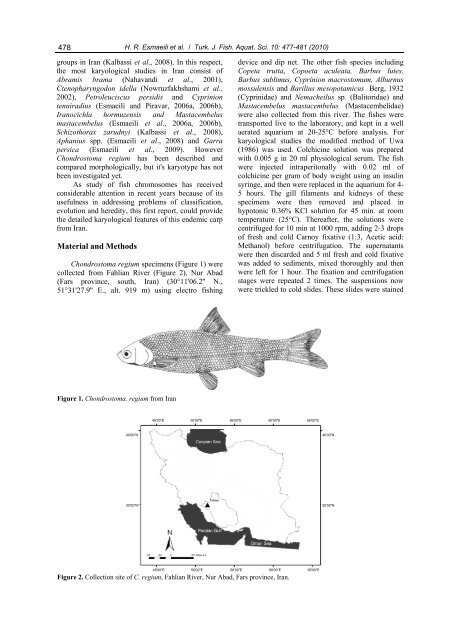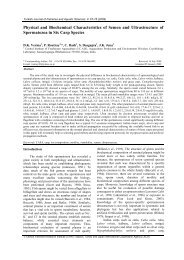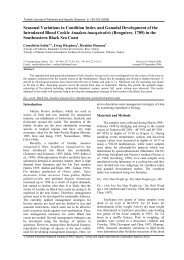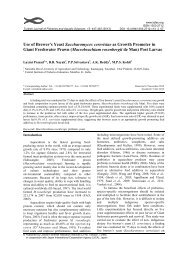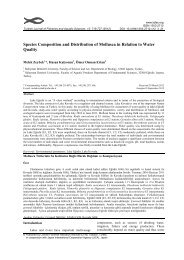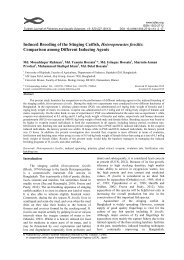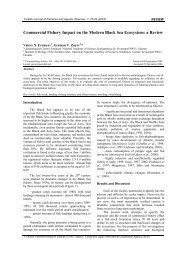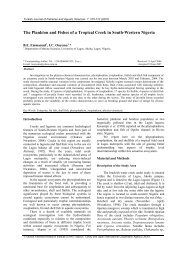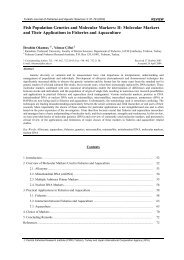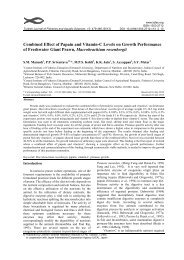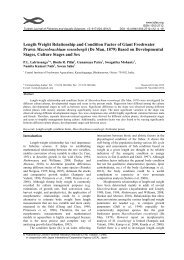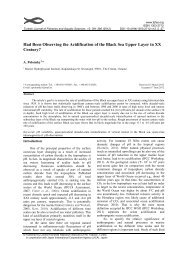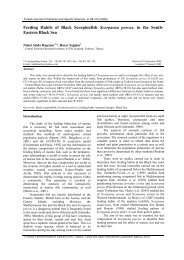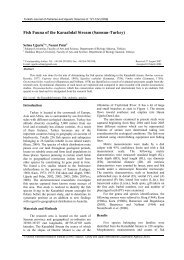Karyotype Analysis of the King Nase Fish, Chondrostoma regium ...
Karyotype Analysis of the King Nase Fish, Chondrostoma regium ...
Karyotype Analysis of the King Nase Fish, Chondrostoma regium ...
Create successful ePaper yourself
Turn your PDF publications into a flip-book with our unique Google optimized e-Paper software.
478 H. R. Esmaeili et al. / Turk. J. <strong>Fish</strong>. Aquat. Sci. 10: 477-481 (2010)<br />
groups in Iran (Kalbassi et al., 2008). In this respect,<br />
<strong>the</strong> most karyological studies in Iran consist <strong>of</strong><br />
Abramis brama (Nahavandi et al., 2001),<br />
Ctenopharyngodon idella (Nowruzfakhshami et al.,<br />
2002), Petroleuciscus persidis and Cyprinion<br />
tenuiradius (Esmaeili and Piravar, 2006a, 2006b),<br />
Iranocichla hormuzensis and Mastacembelus<br />
mastacembelus (Esmaeili et al., 2006a, 2006b),<br />
Schizothorax zarudnyi (Kalbassi et al., 2008),<br />
Aphanius spp. (Esmaeili et al., 2008) and Garra<br />
persica (Esmaeili et al., 2009). However<br />
<strong>Chondrostoma</strong> <strong>regium</strong> has been described and<br />
compared morphologically, but it's karyotype has not<br />
been investigated yet.<br />
As study <strong>of</strong> fish chromosomes has received<br />
considerable attention in recent years because <strong>of</strong> its<br />
usefulness in addressing problems <strong>of</strong> classification,<br />
evolution and heredity, this first report, could provide<br />
<strong>the</strong> detailed karyological features <strong>of</strong> this endemic carp<br />
from Iran.<br />
Material and Methods<br />
<strong>Chondrostoma</strong> <strong>regium</strong> specimens (Figure 1) were<br />
collected from Fahlian River (Figure 2), Nur Abad<br />
(Fars province, south, Iran) (30°11'06.2'' N.,<br />
51°31'27.9'' E., alt. 919 m) using electro fishing<br />
device and dip net. The o<strong>the</strong>r fish species including<br />
Copeta trutta, Copoeta aculeata, Barbus lutes,<br />
Barbus sublimus, Cyprinion macrostomum, Alburnus<br />
mossulensis and Barilius mesopotamicus Berg, 1932<br />
(Cyprinidae) and Nemacheilus sp. (Balitoridae) and<br />
Mastacembelus mastacembelus (Mastacembelidae)<br />
were also collected from this river. The fishes were<br />
transported live to <strong>the</strong> laboratory, and kept in a well<br />
aerated aquarium at 20-25°C before analysis. For<br />
karyological studies <strong>the</strong> modified method <strong>of</strong> Uwa<br />
(1986) was used. Colchicine solution was prepared<br />
with 0.005 g in 20 ml physiological serum. The fish<br />
were injected intraperitonally with 0.02 ml <strong>of</strong><br />
colchicine per gram <strong>of</strong> body weight using an insulin<br />
syringe, and <strong>the</strong>n were replaced in <strong>the</strong> aquarium for 4-<br />
5 hours. The gill filaments and kidneys <strong>of</strong> <strong>the</strong>se<br />
specimens were <strong>the</strong>n removed and placed in<br />
hypotonic 0.36% KCl solution for 45 min. at room<br />
temperature (25°C). Thereafter, <strong>the</strong> solutions were<br />
centrifuged for 10 min at 1000 rpm, adding 2-3 drops<br />
<strong>of</strong> fresh and cold Carnoy fixative (1:3, Acetic acid:<br />
Methanol) before centrifugation. The supernatants<br />
were <strong>the</strong>n discarded and 5 ml fresh and cold fixative<br />
was added to sediments, mixed thoroughly and <strong>the</strong>n<br />
were left for 1 hour. The fixation and centrifugation<br />
stages were repeated 2 times. The suspensions now<br />
were trickled to cold slides. These slides were stained<br />
Figure 1. <strong>Chondrostoma</strong>. <strong>regium</strong> from Iran<br />
45'00″E 50'00″E 56'00″E 60'00″E 65'00″E<br />
40'00″N<br />
40'00″N<br />
30'00″N<br />
30'00″N<br />
45'00″E 50'00″E 56'00″E 60'00″E 65'00″E<br />
Figure 2. Collection site <strong>of</strong> C. <strong>regium</strong>, Fahlian River, Nur Abad, Fars province, Iran.


